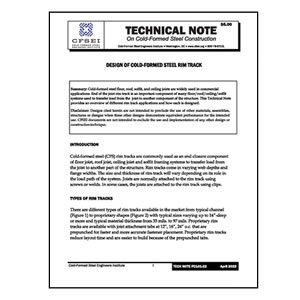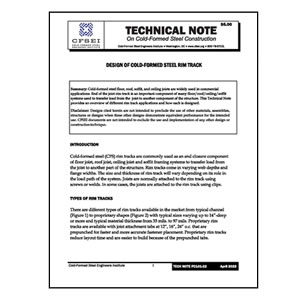Tech Note 558b-1: Lateral Load Resisting Elements: Diaphragm Design Values
$5.00
Archived with cover page Nov. 2011
Summary: This note was archived November, 2011. The author has developed ASD design tables using an analytical method for wood framing based on the provisions of the 1991 edition of the AFPA National Design Specification for Wood Construction. Additional research is needed to bring the data in line with current codes and standards. The data below is from commentary section D2.1 of American Iron and Steel Institute AISI 213, Standard for Cold-Formed Steel Framing – Lateral Design.
Disclaimer: Designs cited herein are not intended to preclude the use of other materials, assemblies, structures or designs when these other designs demonstrate equivalent performance for the intended use. CFSEI documents are not intended to exclude the use and implementation of any other design or construction technique.
Related Products

Tech Note S200-20: Design of Cold-Formed Steel Systems for Raised Platforms, Stages and Theater Seating
Summary: It is common for cold-formed steel (CFS) to be used in the construction of raised platforms, stages, and theater seating. It is the intent of the Technical Note to provide an overview of considerations to address when designing such framing, along with some design examples.
Disclaimer: Designs cited herein are not intended to preclude the use of other materials, assemblies, structures or designs when these other designs demonstrate equivalent performance for the intended use. CFSEI documents are not intended to exclude the use and implementation of any other design or construction technique.

Tech Note W102-21: Introduction to Curtain Wall Design using Cold-Formed Steel
Summary: A curtain wall can be defined as a non-vertically loaded exterior wall (aside for self-weight) support by the primary structural frame of the building. When it comes to cold-formed steel framing, this definition can encompass a great many possible assemblies and applications. This Technical Note discusses the various structural elements of a curtain wall system, and introduces the subjects of design loads and framing analysis.
This Technical Note updates and replaces CFSEI Tech Note W102-12
Disclaimer: Designs cited herein are not intended to preclude the use of other materials, assemblies, structures or designs when these other designs demonstrate equivalent performance for the intended use. CFSEI documents are not intended to exclude the use and implementation of any other design or construction technique.

Tech Note S300-21: Coordinating Cold-Formed with Metal Buildings
Summary: This Technical Note presents a discussion of both the design responsibilities and the need for coordination when integrating field-framed, i.e., stick-built, cold-formed steel (CFS) framing with a metal building system. Important potential coordination topics connection details and design concepts are highlighted.
Disclaimer: Designs cited herein are not intended to preclude the use of other materials, assemblies, structures or designs when these other designs demonstrate equivalent performance for the intended use. CFSEI documents are not intended to exclude the use and implementation of any other design or construction technique.

Tech Note F101-12: Screws for Cold-Formed Steel-To-Wood and Wood-To-Cold-Formed Steel Attachments
Summary: Screws are often used to attach cold-formed steel (CFS) framing to wood members or wood structural panel decking to CFS joists or rafters. The AISI North American Specification for the Design of Cold-Formed Steel Structural Members (AISI S100) provides design equations for screw connection capacity for CFS members. The National Design Specification for Wood Construction (NDS) provides design equations for fastener/connection capacity (nails, wood screws, bolts, etc.) in wood members. The Engineered Wood Association (APA) and the building codes offer several resources for determining the capacity of screw connections attaching wood sheathing. This Tech Note reviews these resources and discusses design and detailing of these fastener connections.
Disclaimer: Designs cited herein are not intended to preclude the use of other materials, assemblies, structures or designs when these other designs demonstrate equivalent performance for the intended use. CFSEI documents are not intended to exclude the use and implementation of any other design or construction technique.

Tech Note B004-20: Introduction to Cold-Formed Steel Framing Standards
Summary: The AISI Committee on Framing Standards was established in 1998 with a mission to eliminate regulatory barriers and increase the reliability and cost competitiveness of cold-formed steel framing in residential and light commercial building construction through improved design and installation standards. This Tech Note summarizes the efforts and work products of the Committee.
Disclaimer: Designs cited herein are not intended to preclude the use of other materials, assemblies, structures or designs when these other designs demonstrate equivalent performance for the intended use. CFSEI documents are not intended to exclude the use and implementation of any other design or construction technique.

Tech Note G801-13: ASTM A1003 – No Cause for Rejection
Summary: Building codes and design standards that reference ASTM International (ASTM) A1003 standard for cold-formed steel framing products have the potential to cause confusion and project delays for those who are unfamiliar with the requirements of this new material standard. This Technical Note, first published in 2008, provides a comparison of the requirements of A1003 with the more familiar standards traditionally used for cold-formed steel framing products, and demonstrates that steel ordered or furnished to the old standards should be no cause for rejection. The 2013 revision references a change to the requirements of ASTM A1003 regarding material thickness when ordering or supplying steel sheet.
Disclaimer: Designs cited herein are not intended to preclude the use of other materials, assemblies, structures or designs when these other designs demonstrate equivalent performance for the intended use. CFSEI documents are not intended to exclude the use and implementation of any other design or construction technique.

Tech Note B009-20: Structural Versus Nonstructural Cold-Formed Steel Framing
Summary: This Tech Note defines structural and non-structural cold-formed steel framing. It lists code definitions that can be used to categorize framing in question.
Disclaimer: Designs cited herein are not intended to preclude the use of other materials, assemblies, structures or designs when these other designs demonstrate equivalent performance for the intended use. CFSEI documents are not intended to exclude the use and implementation of any other design or construction technique.

Tech Note 562-22: Powder-Actuated Fasteners in Cold-Formed Steel Construction
This Technical Note updates and replaces Tech Note 562
Summary: Power-actuated fasteners (PAF’s) are industry standard for attachment of cold-formed steel (CFS) steel framing members, usually track, to concrete, CMU or steel structural elements. “Power-actuated” is the broad category used to refer to fasteners which are driven directly through the CFS and into the substrate, using a powder, gas, compressed air or electro-mechanically driven tool. Efficient installation of framing systems is greatly enhanced by the use of PAF’s. For CFS-to-steel applications, the specification AISI S100 addresses all relevant limit states with equations and safety/ resistance factors. For CFS-to-concrete, limited guidance is provided but not all limit states are covered. This technical note will provide design guidance based on AISI S100, as well as installation and good detailing practice.
Disclaimer: Designs cited herein are not intended to preclude the use of other materials, assemblies, structures or designs when these other designs demonstrate equivalent performance for the intended use. CFSEI documents are not intended to exclude the use and implementation of any other design or construction technique.

